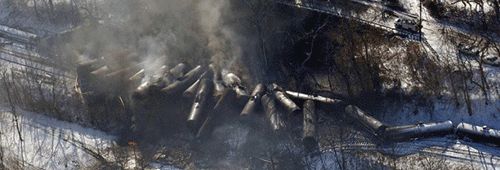SEJournal Online is the digital news magazine of the Society of Environmental Journalists. Learn more about SEJournal Online, including submission, subscription and advertising information.
 |
| Credit: AP Photo/ Office of the Governor of West Virginia, Steven Wayne Rotsch |
After a February 16, 2015, oil train derailment and explosion in West Virginia, new concerns have arisen over the public's right to know about the dangers oil trains pose to communities.
Now trackside communities have some data and maps to help them protect themselves.
Railroads and some states have resisted a federal mandate to disclose routing information for the trains — which often carry explosive blends of crude in strings of 100 or more less-safe tanker cars through communities where even local firefighters may not be warned.
In West Virginia, the state "homeland security" agency refused to give oil-train routing information to the Charleston Gazette in October 2014. This despite the fact that the Federal Railroad Administration (FRA) had ordered the information to be disclosed and that most of it was already public. Their excuse? Trade secrets. Even though the FRA had ruled that oil-train routing information could not be claimed as trade secrets.
The billowing oil fire was no secret to Morris Bounds Sr. of Ansted, W.V., who saw the oil train crash and start to burn some 50 feet from his house, fleeing in his socks in sub-freezing weather because he did not have time to grab his shoes. He lost his house though he escaped with his life.
On May 7, 2014, the FRA issued an emergency order directing freight carriers to use safer tank cars and to disclose routing information to state emergency response agencies. Under heavy lobbying by the railroads, some state agencies chose not to reveal the dangers to the public — although many states did make the information available.
Such secrecy protects the railroads, but not the public. Track maintenance costs money. The idea that secrecy prevents terrorist attacks has lost credibility at a time when a newly revealed U.S. Transportation Department study predicts ten oil or ethanol tank-car crashes per year. Many could be prevented by upgraded tankers and better track maintenance.
The week after the West Virginia explosion, the state of Texas, which had previously refused to disclose oil train routing records to the Associated Press, said it had decided to disclose them. When it will do so is not known.
Most major oil-train routes are already known. People who live nearby can not fail to see the long strings of tankers rumbling by. And maps (some interactive) have been published. Trains magazine published a map of the major routes in 2014 (not available free online). Not long after, the environmental group ForestEthics published a more elaborate "Oil Train Blast Zone" website compiling most known routing information and overlaying it on maps of vulnerable populations and geographic features.
"Oil Train Blast Zone" interactive map site is online here.
- "Statehouse Beat: Refusal To Release Train Info Absurd," Charleston Gazette, October 13, 2014, by Phil Kabler.
- "W.Va. Officials Won’t Release Crude Oil Train Shipment Data," Charleston Gazette, October 8, 2014, by Ken Ward Jr.
- "U.S. DOT Takes New Emergency Actions as Part of Comprehensive Strategy to Keep Crude Oil Shipments Safe," Release of May 7, 2014, Federal Railroad Administration.
- "Man Runs from Home as Train Derails Nearby, Engulfs Property," Associated Press, February 23, 2015, by John Raby.
- "Train Derailments a Concern for Towns Along Rail Lines," Morgan Messenger, February 25, 2015, by Kate Evans.
- "Displaced Families Try To Adjust After West Virginia Oil Train Derailment," PowerSource (Pittsburgh Post-Gazette), February 18, 2015, by Lexi Belculfine.
- "Amid Controversy, Oil Trains Quietly Rerouted Through Virginia Towns," Reuters, February 20, 2015, by Edward McAllister and Jarrett Renshaw.
- "After West Virginia Explosion, Oil Trains Quietly Rerouted Through Virginia Towns," Climate Progress, February 23, 2015, by Emily Atkin.
- "Texas Reconsiders and Will Disclose Oil Train Records," Associated Press, February 23, 2015.
- "Map Shows Areas Most at Risk as Rail Shipments of Oil Continue To Rise," Minneapolis Star-Tribune, July 15, 2014, by Ron Meador.
- "Fuel-Hauling Trains Could Derail at 10 a Year," Associated Press, February 22, 2015, by Matthew Brown and Josh Funk.
- "Revealed: Routes for Trains Hauling Volatile Crude Oil in California," KQED Science, June 25, 2014, by Molly Samuel.
- "Crude-Oil Train Routes in the Region," Philadelphia Inquirer, February 19, 2015.
- Previous Stories: WatchDogs of August 13, 2014; July 17, 2014; and May 28, 2014.













 Advertisement
Advertisement 



